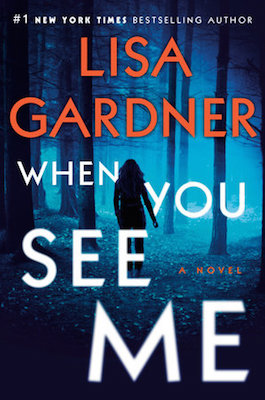
FLORA
D.D. drives. The rental car is in her name and I wasn’t going anywhere without her, that much was clear. Keith sits in the back. I could tell he was torn about joining us, his concern for me warring with his desire to track down that agent and get his hands on Jacob’s laptop. But in the end, he chose me. Should I be flattered?
No one speaks. We stare out our windows, study the bright sky and the miles of concrete that seem to be Atlanta.
I was here once before. In a local hospital after the raid on Jacob’s motel room. Then I was debriefed at the FBI field office, which wasn’t even this field office but a tall black glass monstrosity that looked liked like Corporate‑R‑Us. At least the new brick campus appears governmental. But none of it feels familiar. None of it triggers . . . anything.
I’m still a mountain girl. Which makes the next part of our day—heading north to search hiking trails for human remains—all the more difficult to take. The woods should be a place of respite.
Now all I can think about is Jacob marching some poor girl up a trail to her own death.
The forensic anthropologist is Dr. Regina Jackson. She is a brisk black woman, not surprised to see us, so apparently SSA Quincy phoned ahead. She wears dark blue Crocs, turquoise scrubs, and a white lab coat. She shakes our hands and studies us as hard as we study her. I don’t know much about forensic anthropology, just what I’ve seen on TV. I’m surprised by her surgical scrubs and wonder if we’ve interrupted a dissection.
Then, I can’t help but stare at her thick black hair, pulled back in a tight bun, for any bits of flesh, fragments of skin. Keith is equally wide-eyed, but then, he treats all meetings with real-world crime experts with the wonder other people reserve for star athletes. Prior to meeting me, most of his experience with investigations came from searching the internet for articles on cold cases. Now he’s a regular at BPD headquarters, sitting in on FBI meetings and shaking hands with a forensic anthropologist. Should I be concerned he’s attracted to me for the company I keep?
We clear security, then Dr. Jackson leads us down the kind of long sterile hall that I associate with hospitals, morgues, and government buildings. The floors are polished concrete, the walls painted cinder block, the hanging lights fluorescent. By end of day, everyone must have massive headaches.
She pushes through heavy double doors into a larger, colder space. In the corner, I spy the entrance to what appears to be a small office. Dr. Jackson’s name is next to the door, but she doesn’t head for it. Instead, she cuts a straight line past several large stainless- steel tables—for bodies, for bones? On our right are rows of metal bookshelves filled with what appear to be extra-long shoe boxes. Every box is the exact same color—cream. All are labeled with scrawled black numbers.
Case numbers. For the bones inside. Dozens and dozens of sets of remains.
She is young, I think. Beautiful. Innocent. She is everything Jacob loved to destroy.Again, the three of us proceed in silence, the only sound the clack of D.D.’s heeled boots against the floor. On the far wall is a span of pale wooden cabinets with a solid surface countertop. More workspace, I realize, as the full array of tools, papers, and clutter becomes clear. Then, sitting in a small pool of cleared space: Lilah Abenito.
Her reconstructed face stares at us like a chiseled bust. Dark sightless eyes bore into me. Long brown hair, heavy brows, graceful jawline. As one, we slow.
She is young, I think. Beautiful. Innocent.
She is everything Jacob loved to destroy.
Dr. Jackson explains the facial reconstruction methodology to us: “We are fortunate to have a local artist, Deenah, whom I consider one of the best around. She’s a sculptor in real life, and while I love science as much as the next expert, I believe her when she says all skulls want to reclaim their skin.”
She glances at us, and I realize she’s serious. It makes me finger my own cheeks. Does my skull love my skin? Beside me, I realize Keith is doing the same. We both shudder simultaneously.
“The first step,” Dr. Jackson continues, “is to place markers along the skull to establish tissue depths for the forehead, cheeks, jawline, etc. Once the markers have been placed—which takes weeks of careful measurement—Deenah fills in around each marker with clay.”
Dr. Jackson regards us matter‑of‑factly. “We always use earth-colored clay and brown eyes. In theory, bones don’t tell us coloring, so brown is considered neutral. In the case of Lilah, however, given her Hispanic heritage, the coloring probably is accurate.
“The last step is photographing the results. Deenah takes the final photos herself. Proper lighting is important, and the skull must be shot from several angles. The photos are always taken in black and white—because, again, we can’t be sure of coloring. The images are then loaded into the nationwide database of missing persons. In this case, we had a hit within a matter of days. Lilah Abenito.” Dr. Jackson’s voice softens as she says the name and I realize this process is personal for her. She and this artist have worked together to bring this skull back to life. And in doing so, hopefully grant this girl some justice and her family some closure.
“Once we had a name, I requested Lilah’s full case file, including medical records. I found a notation regarding a fractured left humerus which I was able to match with a healed fracture in the same place on the remains.”
“In other words, you’re certain this is her,” D.D. states.
“As certain as it gets in this kind of work.”
“But you don’t have a cause of death?”
“The remains were discovered fully skeletonized. Unfortunately, there are many CODs that bear no impact on bones. Asphyxiation. Drug overdose. Poisoning. Even exsanguination. As long as the blade didn’t hit bone upon entry, there would be no indicator of the initial wound, or the act of violence that led to death.”
“Can you tell if she was . . . tortured?” I’m not sure how to ask the question. “Signs of cutting, knife work. Maybe not major damage, but something more subtle?”
“Assuming the blade struck bone,” Dr. Jackson says, “yes, we would find evidence. And assuming we had the bone in question. Unfortunately, we’re still missing significant pieces of this skeleton. For example, most of the rib bones are still unaccounted for. At this time, there are more things I don’t know about these remains than I do.”
“Signs of sexual assault?” D.D. again.
“I would need soft tissue to make that determination.”
“But it’s possible she was abducted, raped, killed?”
“Physical restraints can leave markings on a skeleton, especially if utilized long-term.” Dr. Jackson flickers a glance in my direction and I realize she knows exactly who I am. Of course she does. I rub my right hand self-consciously. I still have pale scars around both my wrists. There were times, especially in the beginning, when I struggled so hard, it certainly felt as if my shackles cut to the bone.
It’s an unsettling thought. I’ve always known that Jacob lives in my head. But to think he’s still in my bones, that even if I live another fifty years, when I die and my flesh falls away, I will still be a girl who was kidnapped for four hundred and seventy- two days . . .
Keith’s fingertips whisper across my elbow. As usual, he has followed my line of thinking.
“What about fingertips?” I hear myself ask. “Any evidence of trauma?” Say, endless months clawing against the locked lid of a coffin-sized box?
“I have no phalanges for analysis. Small bones are the first to be snatched by predators. Some might be tucked away in nearby animal dens.”
“That’ll be a fun search effort,” D.D. mutters.
Dr. Jackson shrugs. “You want more information, bring me more bones. As it is, I was able to run tests on lipid degradation in the right tibia’s bone marrow to estimate a postmortem interval of fifteen years.”
“She died fifteen years ago?” I ask uncertainly.
Keith chimes in, “Lipid degradation?”
“It’s a fairly new analysis for establishing time of death in fully skeletonized remains. We know lipids remain in bone marrow for decades. So after taking a biopsy of the marrow—a bone plug removed from the tibia—I analyze it using a high resolution mass spectrometer to determine the amount of lipid breakdown. The result: I can say with some degree of certainty this girl died fifteen years ago. Can I state she was buried then, as well? No. But given the condition of the bones, that’s a fairly safe assumption.”
I nod slowly, then return to studying Lilah Abenito’s reconstructed face
If what Dr. Jackson is saying is true, then Lilah Abenito was dead before I ever headed off to college, danced naively on a Florida beach, and woke up screaming in a pine box. But I feel a connection to her. Whether we have all the answers or not, I already imagine she gazed into Jacob’s leering face, flinched at the feel of his greasy fingers, recoiled at the stench of his body.
The room is closing in on me. I curl my fingers into fists, force myself to focus. They’re looking at me. Dr. Jackson, D.D., Keith. Waiting for me to cry, to break down, to scream wildly—something.
But I don’t want their pity.
And I won’t give Jacob the satisfaction.
“What can you tell us to help us find more of the remains?” I ask Dr. Jackson.
“Dogs,” she states immediately. “I have a lab filled with millions of dollars’ worth of equipment, and I can tell you none of it works as well as a good dog’s nose. I’ve witnessed canines hitting on hundred-year-old remains. What they even smell, none of us can tell you. At that point, there’s no organic matter left; the bone is little more than a dried sponge. But the dogs always know.”
“Approximate search area?” Keith asks.
She shakes her head. “Impossible to tell. The search bias is to head downhill, as it’s easier to walk. When looking for a skull, which rolls, that might help. But we have the skull. We need vertebrae, ribs, phalanges, and plenty of animals head up to stash their treasures, not down.”
“In other words, hike up.” D.D. sighs.
“I’ve found bones in hollow trees,” Dr. Jackson offers. “A decaying log makes a great den for all sorts of small animals, which is what you want to be looking for.”
D.D. frowns. “What do you do, knock on surrounding trees or something?”
“Exactly.”
D.D.’s eyes widen.
“Have you ever been in the woods?” I can’t help but ask her.
“I’ve hiked.” D.D.’s tone is defensive. I realize for the first time that the sergeant isn’t just an urban detective, but a genuine city slicker. I turn toward Keith.
“And you?”
“Um, I think I have a picture of a tree somewhere. Maybe a screen saver.”
“Oh my God, I’m the only one here with wilderness experience.”
“We can’t all grow up in Maine,” D.D. grumbles. “That’s why it’s Maine.”
I feel a renewed sense of responsibility. “Anything else?” I ask Dr. Jackson.
She studies me for a long while. “Examine the topography. Look for signs of water runoff. You’ll want the dogs to trace any and all creeks, as small bones can easily wash downstream. Pay particular attention for debris dams, which may have captured some of the bones. At this stage, they’ll resemble small, weathered sticks so expect to wade into the water, get up close and personal. Finally, check for predator activity, signs of animal dens. In the beginning of decomp, raccoons are the worst. They’ll even crawl right into the chest cavity to gnaw on the ribs, let alone the damage they do to hands.”
I once burned a man alive. But this conversation is making me queasy.
“Small rodents—rats, mice, squirrels—steal bones once they’re dry. Chances are, many of the missing phalanges and ribs are in nests.
So again, you can’t just study the ground. You need to look all around, get a local wildlife expert if you can. Someone who can track small game. I once worked a search where we recovered an arm and half a rib cage from a coyote’s den. That kind of find could make a huge difference for us. I’m assuming you have a search team?”
She glances at D.D., who nods.
“Standard protocol applies. Lay out the grid, work the grid. Then . . . listen. This line of work.” She turns back to Lilah’s graceful face. “Bones talk. And all children just want to go home again.”
__________________________________
From When You See Me by Lisa Gardner. Used with the permission of the publisher, Dutton. Copyright © 2020 by Lisa Gardner.


